Behind the scenes: How Singapore's bird park is moving 3,500 animals to their new home
More than 2,000 birds have acclimated to their new home, says the bird park.
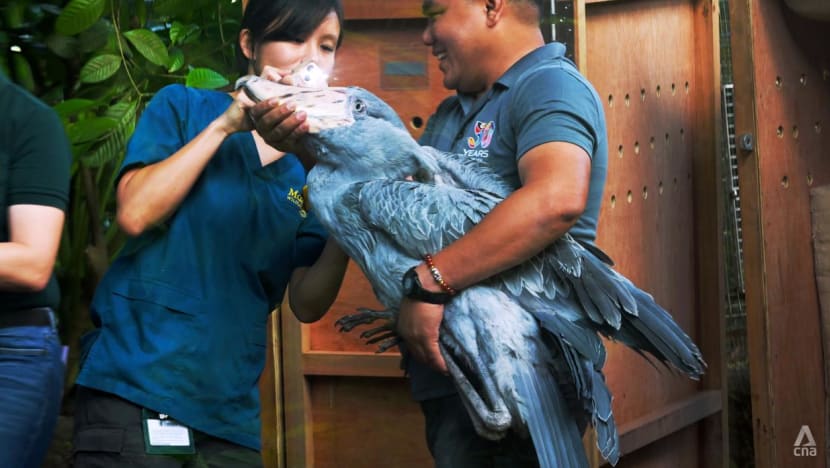
A shoebill getting checked by a vet at Jurong Bird Park before being placed into a crate to be moved to Bird Paradise in Mandai. (Photo: CNA/Try Sutrisno Foo)
SINGAPORE: It took a year of planning and four months to move, but Jurong Bird Park's 400 species of 3,500 birds are nearly ready to meet visitors again at their new home in Mandai.
The new park opens its doors on May 8, with a S$10 (US$7.50) ticket discount for adults and children during its soft opening until May 26.
Tickets for visits from May 27 will be at the full price of S$48 for adults, S$33 for children aged three to 12 years old, and S$20 for senior citizens.
The 17ha attraction – about the size of 24 football fields – will be open daily from 9am to 6pm, with the last admission into the park at 5pm.
Since January, 80 staff members from the animal behaviour and programmes team, veterinary healthcare and animal care teams have worked tirelessly to move the birds in the safest way possible.
“One essential part of the planning for the full move was how do we transport every single bird species in the best possible way that avoids stress, and is also the safest way possible?” said vice-president of the park’s animal care team Luis Neves.
Planning for the move took more than a year, with the relocation taking about 16 weeks. The move could have been faster, but the park prioritised the welfare of the birds, he said.
“We could’ve said we’re going to do this in a much shorter span of time, but we didn’t do that. We wanted to make sure that between each batch of birds, they had time to adjust, we had time to observe them, and if there was something to correct, we would have time to do so," Dr Neves told CNA.
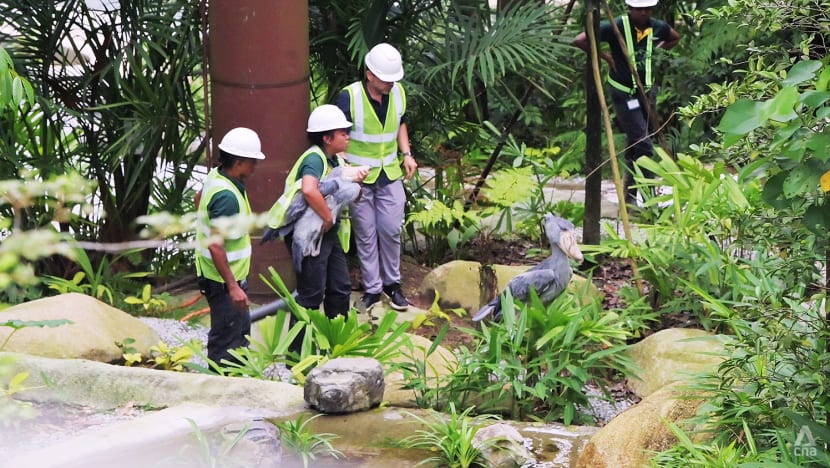
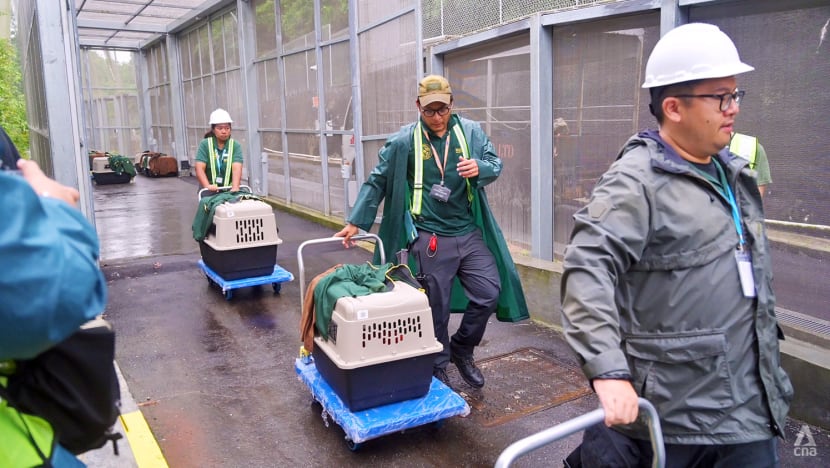
Moving the birds is a delicate task, often involving multiple keepers moving the tiniest birds into boxes. The process for taller, leggier birds can be more complex because they risk injuring themselves, said Dr Neves.
“For animals like storks, cranes, because they’re so big and they’re so strong and it’s so easy for them to injure themselves, we use a net to quickly restrain them and then we quickly wrap a towel around them and make sure they cannot flap their wings,” he continued.
“In a way, it’s not different from when you bring your cat to the vet.”
For the safety of some birds like the shoebills, some feathers were trimmed to stop them from flying into obstacles and injuring themselves when introduced into the new aviary.
Keepers stressed that this was a temporary measure. Feathers are made of keratin – like human nails and hair – and these birds will naturally grow new feathers through their moulting cycle, allowing them to take flight again.
So far, more than 2,000 birds have made it to their new home in Bird Paradise.
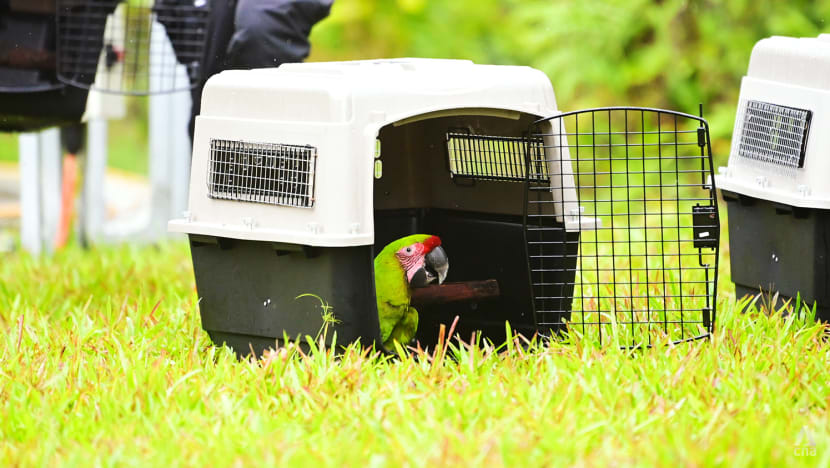
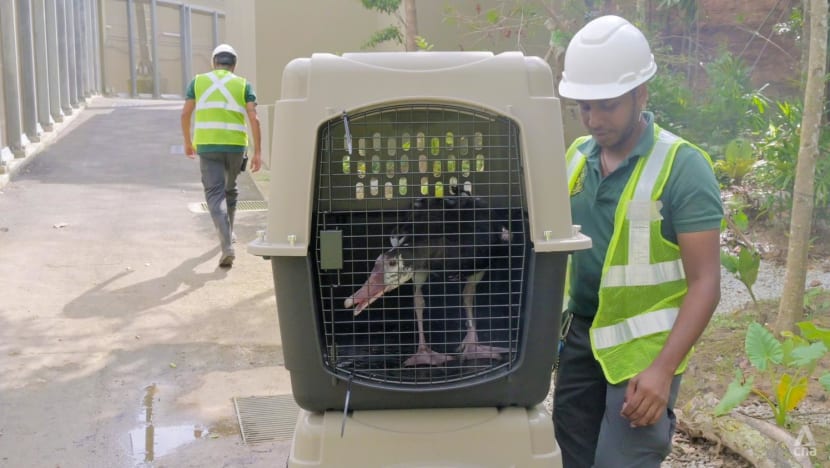
The penguins will be among the last few to make their move before the park opens, said Dr Neves, describing the move as “straightforward” but “also very complicated” because they require special conditions.
“All the birds that come from Jurong come in trucks, which are air-conditioned and fully enclosed so that they don’t get stressed,” he shared.
But the penguins need to be transported at a lower temperature.
“They will actually come in on a truck with ice around, and they actually will be coming in little containers, where a couple of penguins are, with a bag of ice. That way they are actually together so they are not stressed, but at the same time they are not overly heated because of the ice.”
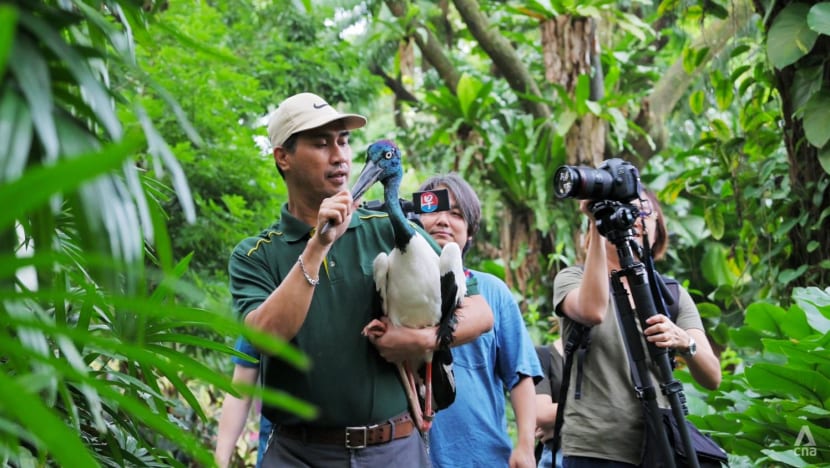
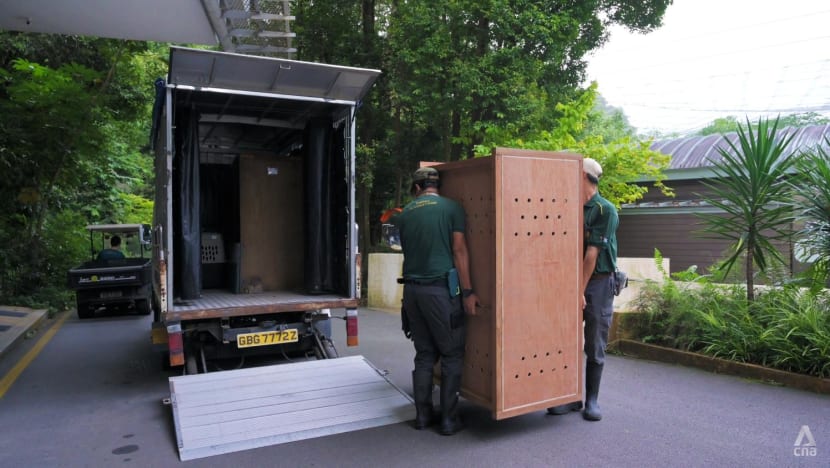
Rain or shine, the team of keepers worked hard to make the move happen.
Most times, the pet carriers carrying smaller birds were draped in old, unwanted Mandai T-shirts. This keeps the birds calm by shrouding them in darkness. On rainy days, the covers also helped to keep the birds dry.
The heavy rain in the last few months stopped the move a few times, said Dr Neves.
“We felt that it is not safe for the animals to come in on a very rainy day. We want the birds to come and have the full day to actually adapt,” he said, adding that the moves usually start early in the morning.
“If it’s a very rainy day, it’s a bit more difficult for the birds to adjust and for the birds to find food readily, and shelter as well, because they wouldn’t know where the shelter is. We wanted to make sure that the birds have the best possible options as far as settling down.”
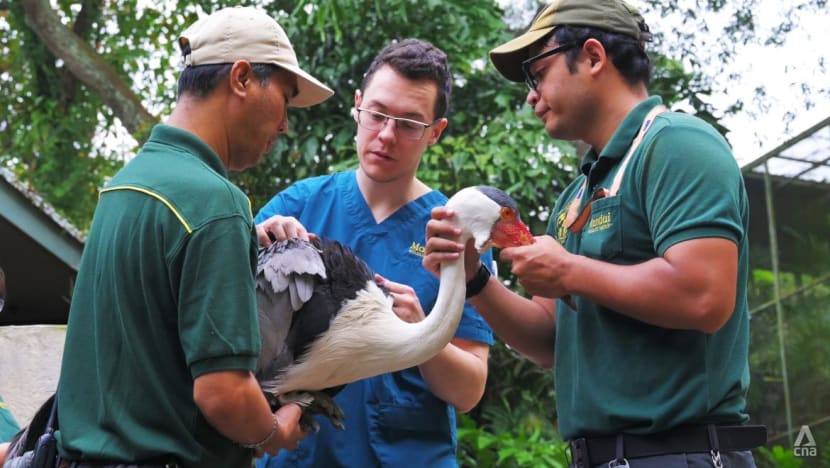
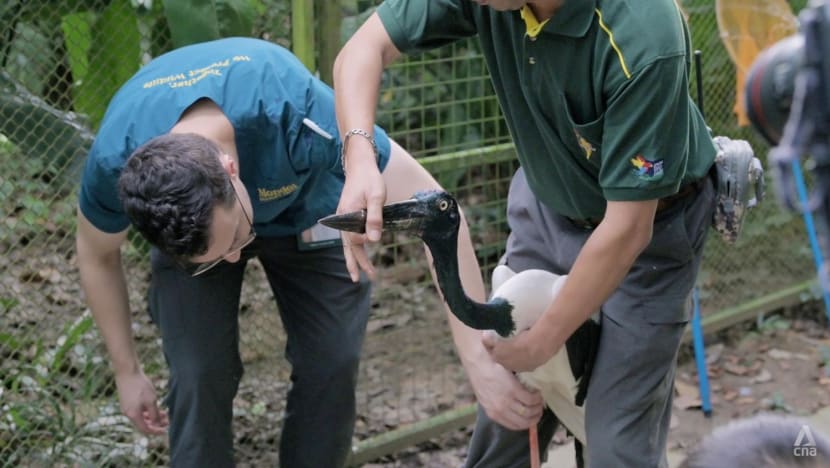
Moving Mary the stork
On Feb 24, journalists were invited to watch as keepers transported a black-necked stork and a wattled crane from Jurong Bird Park to their new home in Mandai.
Mary, the black-necked stork, paced between two trees in its outdoor enclosure.
Two keepers entered the enclosure, each wielding a net. The stork tried to fly upwards but a wave of a net over Mary’s head forced it to land.
Senior keeper Sadali Mohamed Tali then gingerly grabbed Mary by its neck, went behind it and folded its wings into its body. He lifted the leggy bird up and out of its enclosure where a vet was waiting.
The vet greeted Mary with a brief examination of its wings and feet. Seeing that there were no issues with the stork, he gave the all-clear for Mary to be transported to its new home.
Mr Sadali carried the stork while hugging it with his left arm and his right hand clenched firmly around the bird’s sharp beak. He then swiftly placed Mary into a wooden crate with padded interiors that was about 1.5m tall.
Once secured, Mr Sadali and another keeper loaded the crate onto the back of a lorry.
Before the lorry could leave Jurong Bird Park for Bird Paradise in Mandai, it had to wait for one more passenger - a wattled crane. Once the tall bird was loaded onto the lorry, the two birds made their way to Mandai in the comfort of an air-conditioned storage compartment.
Upon reaching Bird Paradise, the crates were offloaded outside a gate along a service road at the back of the Heart of Africa aviary. Signs reading “Warning! Aggressive birds inside” hung on the metal fencing.
Placed on a trolley, one crate was wheeled up a slope and at the planned point of release, three keepers placed the crate on the edge of the vegetation and opened the crate’s door wide.
Inside the crate, the wattled crane hesitated before walking out. After a few “good boys” and “come ons” from one of the keepers, the crane warily inched out of the crate before walking into the bushes of its new home.
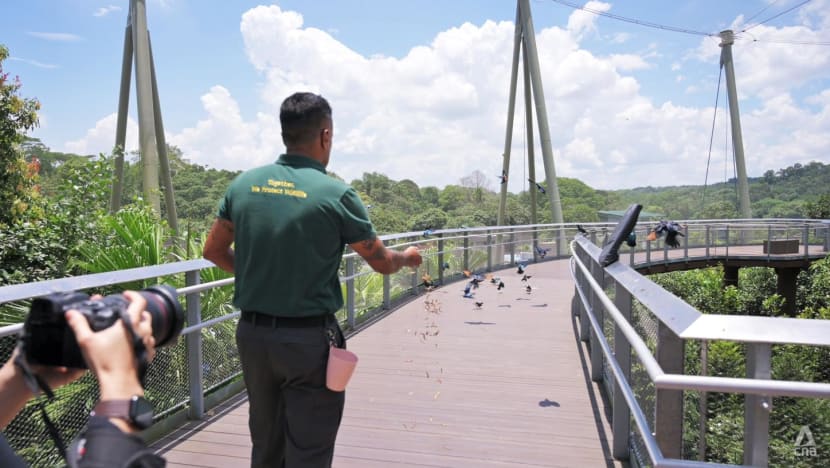
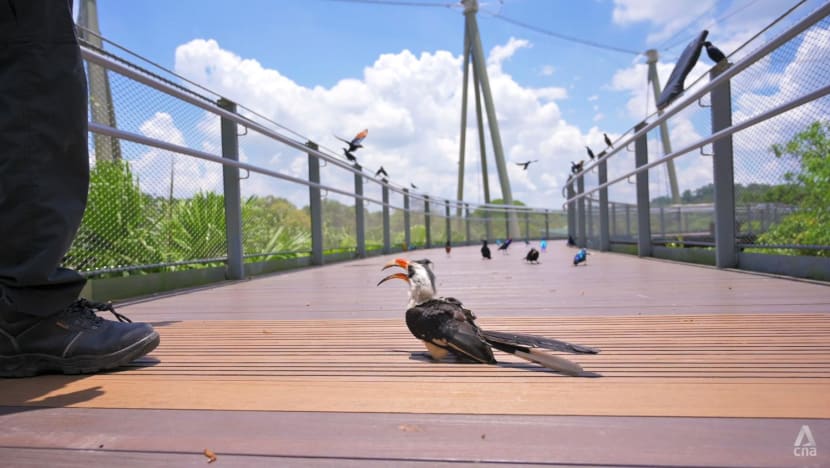
HEART OF AFRICA AVIARY
The Heart of Africa aviary is the biggest aviary at the new park, housing more than 500 birds.
One of the head keepers for the aviary Vijay Madhavan used a whistle to call the starlings to a spot on one of the bridges and the flock descended.
Dishing out mealworms from a small bucket strapped to his waist, Mr Madhavan counted the birds and explained the purpose of recall conditioning.
Using a whistle and then doling out food will let the birds know that whenever they hear the whistle, there will be snacks waiting for them, he explained. While the birds are picking at their food, keepers check that the birds are healthy.
Given their differing sizes and colours, not all the birds are easily tracked, he added. For example, the crested coua, which did not make an appearance that day, can be difficult to find because it is shy.
“So what we will do is that, throughout the whole day, someone will walk around and look for them, but we can’t account for them today,” he said, noting that the keepers will report the number of birds they spot.
The team has been doing recall conditioning for the birds since they lived in the African Treetops aviary in Jurong Bird Park, so it was easy to get them to adapt.
“As we add new species, new birds, new members to the flock ... that species hopefully will follow the current ones, which is usually what happens most of the time,” said Mr Madhavan.
The aviary can comfortably hold more than 2,000 birds and there are plans to add more species, he shared. Some of the birds have started to breed.
The first few days in the new, larger aviary were “a rude awakening” for staff, Mr Madhavan said.
“Previously, everything was flat. Now, you take 36 steps all the way up, and you have to carry a lot of food and walk a lot more. I think my staff, most of them have lost a bit of weight.”
The new park has eight walk-through aviaries, including the Heart of Africa, and two other zones, which will each house the park’s penguins and its critically endangered species.
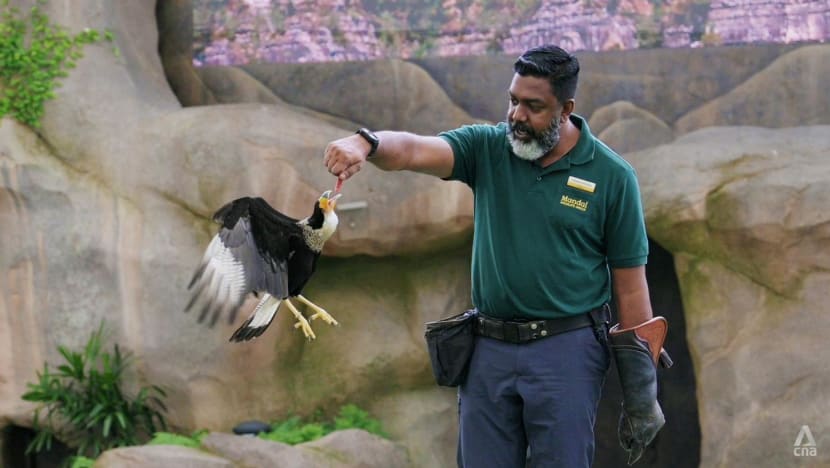
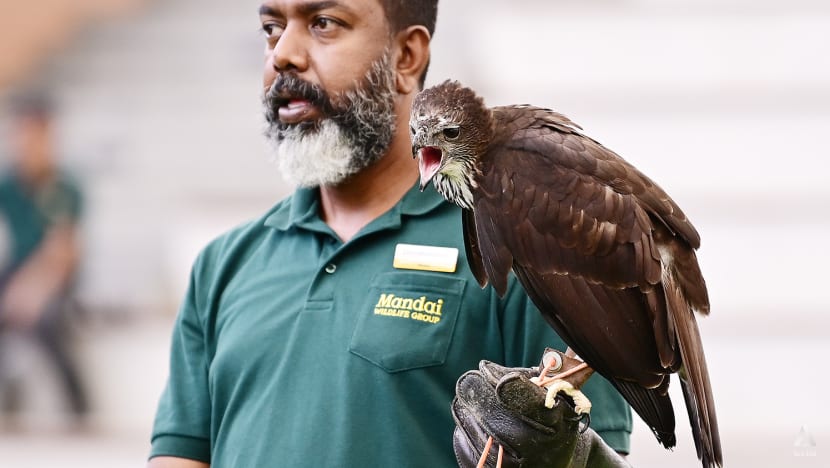
NEW SHOWS
Mr Chandramohan, a manager with the animal behaviour and programmes team, works with the park’s birds of prey, getting them comfortable with the new Sky Amphitheatre.
The space will host two new avian presentations – Predators on Wings and Wings of the World – taking cues from the previous Kings of the Skies and High Flyers presentations at Jurong Bird Park.
The new amphitheatre is meshed up and has double the capacity of the previous one in Jurong.
When the birds first arrived at Bird Paradise, they were left to explore the space in and around the new amphitheatre.
After that, the keepers walked around the theatre with the birds sitting on their arms to get them comfortable with their new environment, Mr Chandramohan shared.
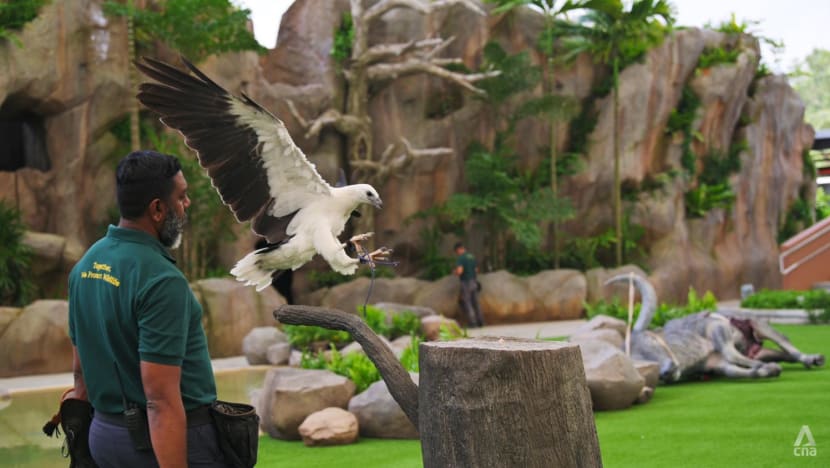
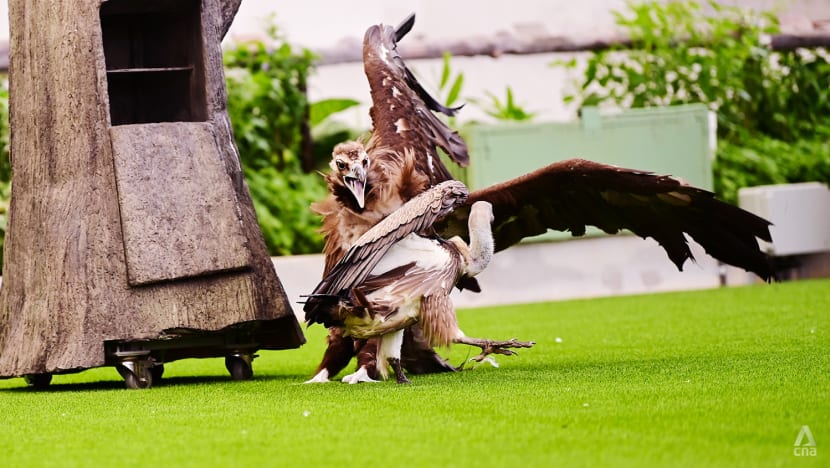
The new amphitheatre will feature an LCD screen, which will be used to showcase the birds in greater detail during the shows. This inclusion also presented a big challenge to the keepers when planning for the shows.
“Initially, when we had the birds out here with the LCD screen, they kind of paused for a while and they turned around to look at the screen, and were a bit dazed for a while,” he added with a laugh.
But within a day or so, the birds got used to the screen, said Mr Chandramohan, adding that he was quite happy with the progress.
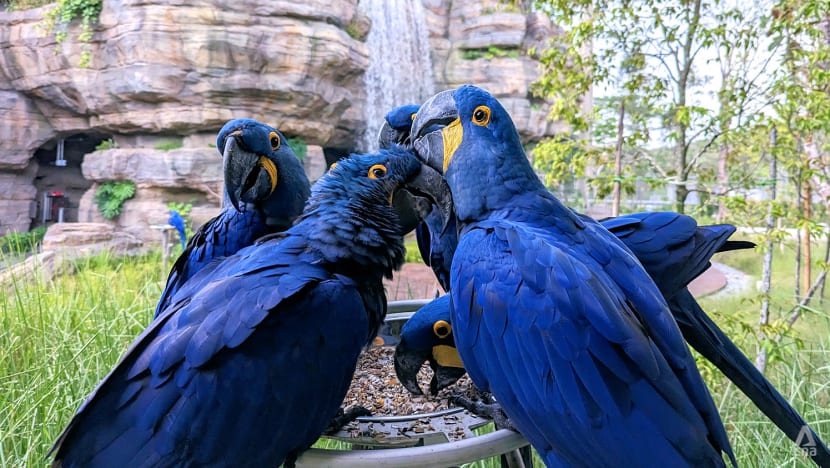
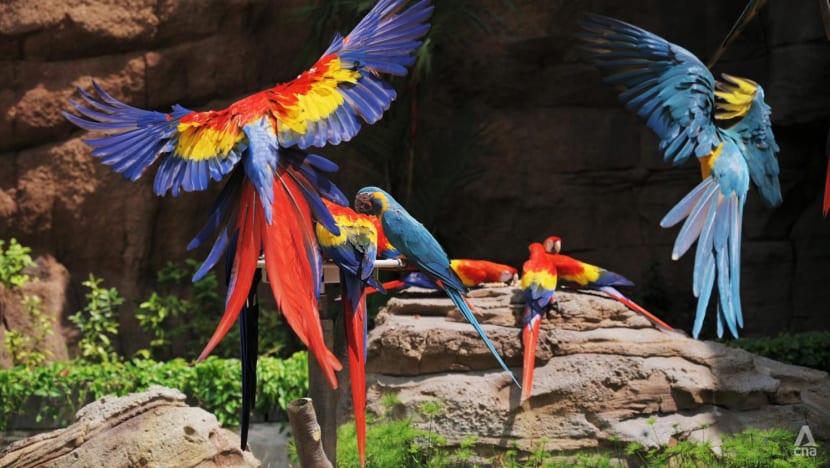
CRIMSON WETLANDS
Keepers also had to train the macaws in the Crimson Wetlands aviary to get them accustomed to their new home.
The new walk-through aviary is a pleasant change from their previous enclosures – for visitors and birds alike. The birds are now free to roam the whole aviary, often streaking rainbows in the sky as they whizz from tree to tree.
Since the aviary is much bigger, the team decided to switch from using a whistle to an electric buzzer, so that the birds can hear the call easily, said deputy head keeper Farhan Hamzah.
Now that they live in large aviaries, rather than caged enclosures, keepers have also started doing recall training to check on the birds’ health and make sure they know where to look for food.
The Crimson Wetlands aviary is home to about 300 birds, including parrots, macaws, and the park’s flamingos.
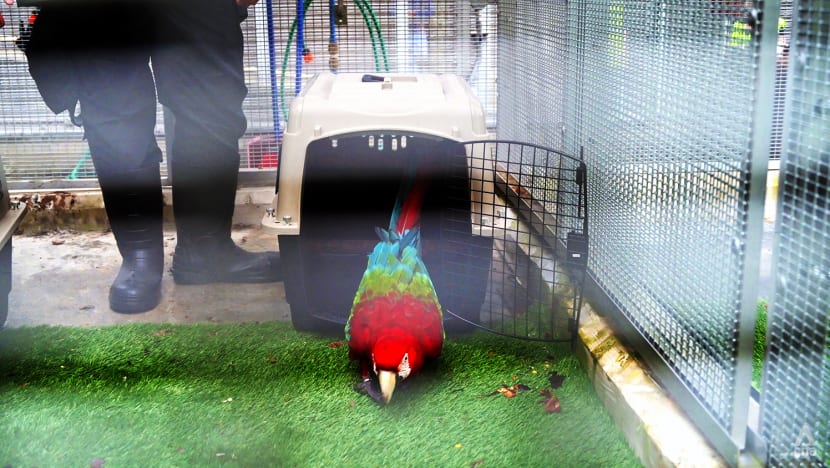
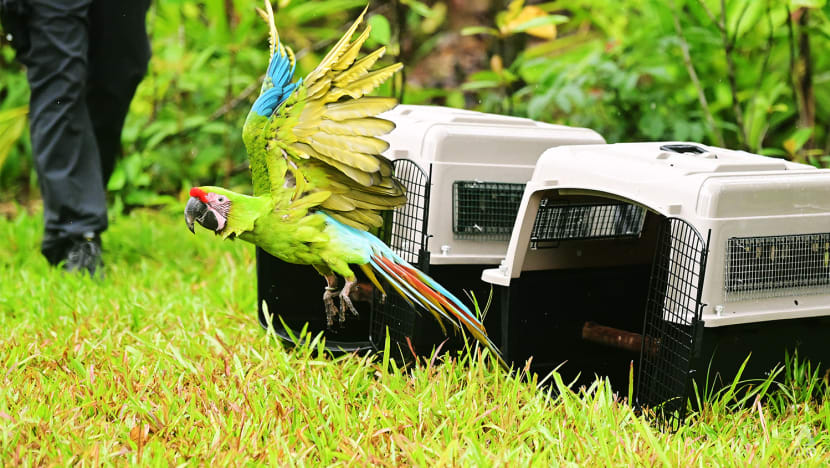
Two keepers encouraged squawking scarlet macaws to fly between a few tall posts set up near the waterfall in Crimson Wetlands by offering them walnuts and macadamia nuts.
The large hyacinth macaws were calmer on their perches, while the smaller blue macaws, red-fronted macaws and blue-headed parrots ambled around on the floor, eating out of dishes.
Because they used to live in smaller enclosures, some of the birds are very familiar with humans and their keepers, and sometimes land on shoulders or nibble on loose-hanging items.
“Crimson Wetlands is an open concept aviary, and the public or the guests are going to have a close encounter with the macaws. So some of the macaws, they are very used to an aviary, but not something in this large scale,” said Mr Farhan.
“We want to make sure that they are able to separate the positive behaviour, which is maintaining a distance from the guests.”
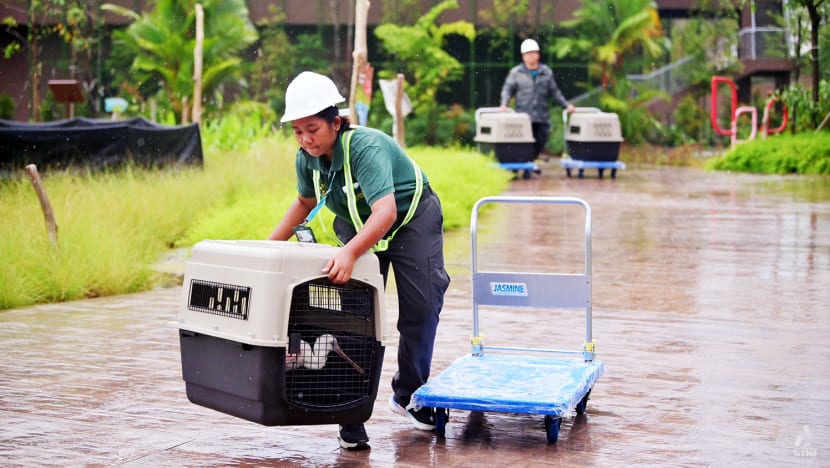
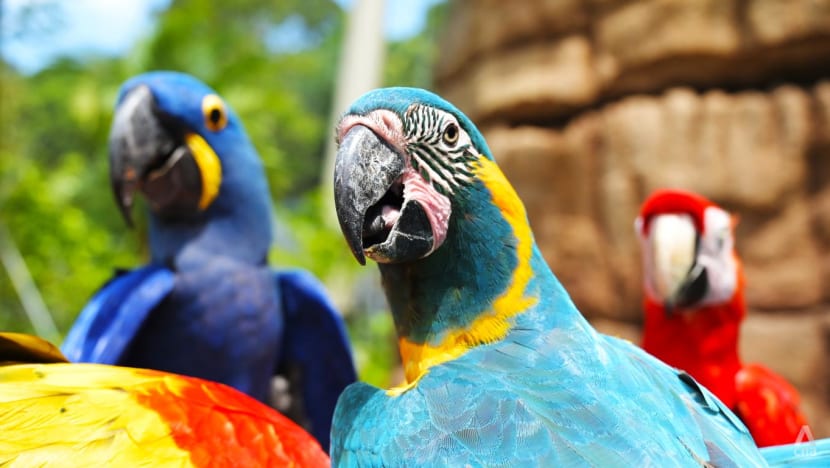
All of the aviaries in Bird Paradise are a minimum of about 0.3ha each, which is the size of the second-largest aviary at Jurong Bird Park, said Dr Neves.
With so many birds under their watch, how does the team know that every last bird is with them?
“Part of this exercise is making sure that all the data comes with us and that we record everything that comes to Bird Paradise so we know exactly how many birds are left,” Dr Neves said.
Each bird has an individual ring or microchip that helps the park track them.
“This new park is much bigger ... so what will happen is not only will the birds start to live here, and as the park matures, we’ll also end up bringing in more species that actually fit our storyline, which is basically celebrating birds, and making sure people understand how important birds are to ecosystems and the conservation work we do," he said.


















